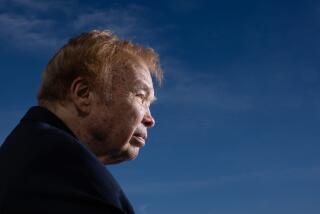Book Review : The Faces Behind Many Notable Cases
The Courage of Their Convictions: Sixteen Americans Who Fought Their Way to the Supreme Court by Peter Irons (Free Press/Macmillan: $22.95, 420 pages)
Shortly after starting law school, I was delighted to discover that the case law of the American judicial system amounts to a mammoth library of dramatic narrative. Each opinion of an appellate court arises from a “case or controversy”--that is, a struggle between human beings over love, money, liberty or power--and each case book is rather like a collection of short stories. To this day, if I lack for quick leisure reading, I will pull a copy of California Reports off the shelf of my law library and read a case at random.
Peter Irons approaches the daunting subject of constitutional law with a similar (if distinctly weightier) attitude in “The Courage of Their Convictions.” He reminds us that much of the recent struggle for civil rights and personal liberty in contemporary America has been conducted in the courtroom, and he encourages us to look beyond the headlines and the op-ed pieces to see the intimate human values that are often at stake in a constitutional lawsuit.
“Almost without exception, the notoriety of Supreme Court cases is matched by the obscurity of the people who began them,” Irons explains. “What little we do learn is distorted by the media’s lust for the sensational and the trivial.” His solution is to allow 16 otherwise anonymous constitutional litigants--”women and men . . . black, white, Hispanic and Asian . . . gay and straight . . . carpenters, bartenders, doctors and lawyers”--to speak for themselves.
Just the Facts
Each of the 16 cases is treated in two parts--first, Irons narrates the facts of the case and discusses the holding of the Supreme Court, and then the man or woman behind the lawsuit gives a first-person account of his or her experiences as a “test case.” In that sense, “The Courage of Their Convictions” is a kind of annotated oral history of constitutional law in America--a footnote that gives a name and a face, a heart and soul, to what Irons characterizes as “a living Constitution.”
At its best, the book reveals and explains the scholarly but spirited debate--and the considerable intellectual contortions--that are the stuff of a judicial decision. At the same time, Irons allows us to understand that the law has an intimate and sometimes overwhelming impact on the human beings whose lives and liberty are at risk.
“We live by symbols,” Justice Felix Frankfurter wrote (quoting his “judicial hero,” Justice Oliver Wendell Holmes) in an 8-to-1 decision upholding the expulsion of a schoolgirl named Lillian Gobitis, a Jehovah’s witness, for refusing to salute the flag in a Pennsylvania schoolroom in 1935.
“I loved school,” Lillian Gobitis recalls of her childhood ordeal. “I was actually kind of popular. And I felt that, ‘Oh, if I stop saluting the flag, I will blow all this!’ And I did.”
A Test Case
We hear, too, from Gordon Hirabayashi, a college senior who refused to sign up for “relocation” after Pearl Harbor: “I had no plans to being a test case,” he recalls. “I was so naive, I’d never even seen a jail.”
Dr. Jane Hodgson is a physician who challenged a Minnesota law against abortion: “It gradually dawned on me that this was lousy medicine we were practicing, and something ought to be done about it. But I never thought I’d see it in my day. I thought it would take forever.”
Elmer Gertz is a Chicago lawyer who helped to change the laws of libel in protracted litigation against the John Birch Society: “One interesting thing about the case is that actually my earnings did not decrease. They went up!”
‘The Door ... Opened’
And Michael Hardwick is an Atlanta man whose arrest on charges of sodomy prompted a recent unsuccessful attack on laws against private sexual conduct: “The door . . . .opened up and I looked up and there was nobody there. I just blew it off as the wind and went back to what I was involved in . . . I heard another noise and I looked up, and this officer is standing in my bedroom.”
Irons, a draft resister in the 1960s and a Harvard-trained civil rights lawyer today, teaches political science at UC San Diego. He is the author of “Justice at War,” a chronicle of the unsuccessful legal challenges to the wartime internment of Japanese Americans. So we should not be surprised that his book focuses exclusively on what he characterizes as “some of the deepest and most enduring divisions among Americans--those of religion and race, protest and privacy,” as he puts it.
Nor should we be surprised that the book reads all too often like a friend-of-the-court brief for the litigants and their causes. Irons is an unabashed activist, and he concludes his book with a call to further activism in the courts: “All we can hope is that Americans like the people in this book, people with both courage and conviction, will continue to bring these issues to the courts, and that judges will look behind the ‘masks of the law’ to see the many faces of America.”
More to Read
Sign up for our Book Club newsletter
Get the latest news, events and more from the Los Angeles Times Book Club, and help us get L.A. reading and talking.
You may occasionally receive promotional content from the Los Angeles Times.









